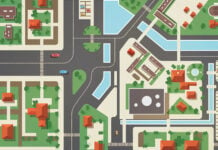The organization of buildings and its relationship to the landscape can tell us a lot  about the energy and vibrancy of an area. Buildings are portrayed as monolithic masses, constructed out of hard steel or concrete, which brings a sense of ‘hardness’ to any environment, while the immediate landscape offers a medium to balance out this urban jungle. By becoming aware of your surroundings, you will backdrop to create a good yin and yang balance in the city.
about the energy and vibrancy of an area. Buildings are portrayed as monolithic masses, constructed out of hard steel or concrete, which brings a sense of ‘hardness’ to any environment, while the immediate landscape offers a medium to balance out this urban jungle. By becoming aware of your surroundings, you will backdrop to create a good yin and yang balance in the city.
In any modern city, you find the colossal massing of buildings overwhelming the city skyline. Yet in niche corners you will find areas which exemplify the ideal balance of building and landscape. Take the City of London for example. Deep within the newly formed district, skyscrapers of glass and steel tower up high, yet when you visit such areas, you find a sense of space and freedom. The secret is the master plan of how buildings relate to each other with a centralized park system.
The parks of Canary Wharf offer a vital solution in creating this yin-yang relationship. By building around a central park system, it allows all immediate buildings to embrace their own open space or ‘bright hall’. Symbolically, this reflects the means for each building to tap the opportunity luck laid before it.
However, more importantly is how such parks create a buffer zone to prevent the entrances of such buildings confronting each other, thus setting a natural tone of harmony within the urban landscape. In doing so, it also allows a natural setting for people to collect thus creating vibrant yang energy at the entrance of each building within the neighborhood.
Water plays a vital role in setting up vibrant yang energy. Seen inside Jubilee Park, this centralized water feature landscape allows the surrounding buildings to each have a front view of water. The introduction of water plays a vital role in the creation of wealth luck. Such features illustrate the ideal system as it integrates not only the flow of water through gentle drops in level to symbolize a waterfall, but also the gush of water upwards as if pushing wealth up from the ground.

However, the most important aspect of water is its flow and its relationship to the building. Water should always be seen to flow towards the entrance in a meandering fashion. Through a curvilinear form, it not only helps to regulate a gentle water flow but at the same time create a symbol of the water dragon. To fully tap the power of water, the most ideal situation is to locate such water features at the location of the water star #8, based on Flying Star feng shui, or in the Southwest sector of the building, to tap the indirect spirit of the Period of 8. This information can be obtained only by analyzing the facing direction of each building and entrance lobby.
Another means of creating balance in the building is to integrate ‘soft’ landscape features into the building interiors. Not only do trees help soften the hard atmosphere of glass and steel, it helps break up any strong chi or poison arrows that may be pointed at a building lobby. In the city where we are exposed to the hard elements of the built environment, there is a need to bring a sense of balance to the elements we are exposed to. The typical three main elements of a building comprise of (light) fire, concrete (earth) and steel (metal), so by introducing wood and water into the building landscape, it helps bring a unified balanced of elements and energies into the city landscape.
Symbols Of The World
Symbols can be found in all walks of life; either through abstract translation in building or literal definitions. Sometimes we pass by these symbols without realizing what they are or mean, or sometimes we try to match such symbols to those we encounter through our experiences. One such form came to my attention during my travels and is encompassed in the form of a capsule-like design. Looking at the abstract, such capsule forms can also be represented through the form and design of the dzi bead.
A fine example of form following function is 30, St. Mary Axe which rises up through the city skyline like a pyramidal dzi bead. On the other end of the Thames River, the Millennium Eye looks like a bracelet of dzi beads. As both features represent auspicious symbols of good fortune, there is no doubt that one resides within the financial district and the other opposite the House of Parliament. Seen all across the city skyline from the River Thames, these two superstructures illustrate the use of powerful symbols as an architectural language to serve not only a functional purpose but also a symbolic gesture of good fortune.
So like many literal translation of building forms, the abstract forms call for imagination. Observe your surroundings and you will start to adopt an eye for space, energy and buildings formations of the modern world.
























